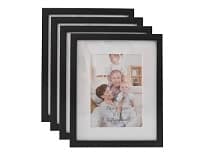 It is common to find the term portrait frame written in writing, referring to the portable frame used to display photographs . However, this concept entails a misspelling since its correct form is portrait , with a double R after the first A and before the E.
It is common to find the term portrait frame written in writing, referring to the portable frame used to display photographs . However, this concept entails a misspelling since its correct form is portrait , with a double R after the first A and before the E.
This is because the letter R can represent two sounds : erre (as in “backwater” or “grill” ) or ere ( “die” , “knob” ). The representation of the sound err when the R appears between two vowels requires the duplication of the letter ( RR ).
In compound words , if the first element ends in a vowel and the second begins with R , doubling is necessary to maintain the erre sound. For this reason, portrait is written with a double R and not a single R. Porta- ends in the vowel A and portrait begins with the consonant R , which must be doubled.
Another issue to take into account when writing a portrait is that the Royal Spanish Academy ( RAE ), in its dictionary, also accepts it as a portrait , with a final S. Thus, one can speak of “the portrait frame” or “the portrait frame.”
Regarding the meaning of the notion, a photo frame is an object that is used for the exhibition of a photograph . It usually has a foot on the back so that it can stand up and be supported on a piece of furniture, such as a shelf, desk or table . There are also hanging photo frames (to be placed on the wall with the help of a nail) and digital photo frames .
 Picture frames, in short, are items that are present in most homes. People generally choose family images as home decoration , although they can also show photographs of their friends or their pets. In the workplace it is also common for people to place photo frames on their desks.
Picture frames, in short, are items that are present in most homes. People generally choose family images as home decoration , although they can also show photographs of their friends or their pets. In the workplace it is also common for people to place photo frames on their desks.
The main use of the portrait frame is to display a photograph somewhere in the house or office, but beyond its practical application there is a series of feelings that can prompt us to make this decision or to do without it. One of the reasons why we usually use a photo frame is the need to keep in mind certain people or animals whom we love and want to see throughout the day. Here we can stop to contemplate two cases, because sometimes we need to remember those who have died, and a photograph of them in our living room can give us a little peace when their loss causes us the most pain.
In fact, photography itself as a discipline responds to that obsession that human beings have with achieving immortality. He began doing so with cave paintings and went through the various eras of art on canvas until reaching photography and cinema, without leaving aside audio recordings. We are afraid of death, of being forgotten, and that is why we are fascinated by the mere idea of capturing small portions of our existence on paper, magnetic tape or memory cells; Whatever the storage medium, if we are recorded, there will always be someone who will keep us in mind.
Therefore, the portrait is combined with photography to make someone's absence less harsh, but it can also simply serve to remember a trip or an event with someone who still lives with us. With the arrival of its digital version on the market and the massification of smartphones , the use of a traditional portrait frame is increasingly rare, partly because it is limited and uncomfortable in comparison.
